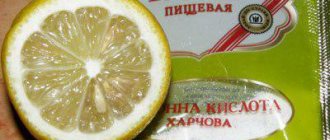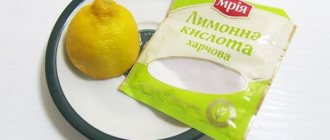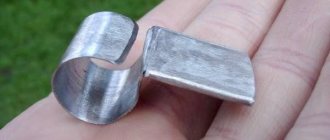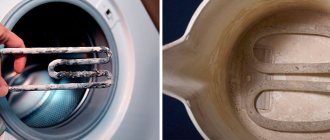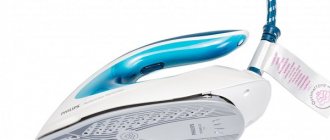An additive such as citric acid, also known as E330-E333, is found almost everywhere today: from food, cosmetics and medications, to construction, oil and gas industries.
Many people are wondering how citric acid is made and what kind of substance it is. Citric acid was first made from unripe lemons by Swedish pharmacist Carl Scheele in 1784. For a long time it was synthesized from lemons and shag, but the yield of the final product was only 5-8%.
Application of E330
Substance E 330 is most often used in the food industry. Acts as:
- antioxidant – prevents oxidation;
- preservative – extends shelf life;
- stabilizer – improves consistency;
- flavor enhancer - makes it richer and more pleasant;
- acidity regulator – controls the acid level.
E330 interacts well with other nutritional supplements. When mixed with E500 (soda), the substances act as a leavening agent for the dough, making it more fluffy.
Found in the following foods:
- confectionery products;
- juices and carbonated drinks;
- bakery products;
- canned vegetables and fruits;
- meat and fish products;
- cheese products.
The list of products in which E330 can be used is regulated by GOST 31726–2012. Contains about 70 titles.
In sausage products it is often used in combination with acidity regulators E262, E331 and stabilizers E339, E450, E452.
In addition to the food industry, the substance is actively used in cosmetology. Included in peelings and cleansers. Has antibacterial properties. Other areas are pharmacology and household chemicals.
Receiving technology
The first mention of citric acid dates back to the 18th century, when it was synthesized from the juice of unripe lemons .
In the last century, the production of citric acid was based on mixing lemon juice with shag.
The substance obtained in this way was completely natural . With the development of industry, this method became costly and unprofitable.
Nowadays, hydrocarbons (sugars, starches) contained in beets, corn, wheat, and potatoes are used to produce the E330 additive.
Using mold strains, they are fermented and fermented, resulting in a liquid with 90% citric acid content.
Purification from unnecessary impurities is carried out by adding a mixture of slaked lime and water or precipitated chalk. Crystallization is achieved by evaporation in a vacuum unit. The finished product is dried and packaged in bags.
Volume to weight ratio
You can measure citric acid in grams without scales using small and large spoons:
- in a tablespoon – 15 grams;
- in a dessert spoon – 10 grams;
- in a level teaspoon – 5 grams of acid.
The juice of one lemon is equivalent to approximately 5 g of citric acid. An average pack of acid contains 50 g. Also on sale are small bags weighing 10–25 g, medium bags weighing 50–100 g, and large bags weighing 250 g.
What to look for when choosing “Limonka”
- The tightness of the packaging is the main indicator that you need to pay attention to when purchasing citric acid. Broken packaging may indicate improper storage or transportation of the product.
- Also pay attention to the dryness of the packaging material. A humid environment causes the powdery substance to clump and compact. This is a consequence of the loss of the positive qualities of citric acid.
- Another important criterion that also needs attention is the shelf life of the product. Expiration of the period will not lead to any external changes in the acid, but will make the product completely useless and tasteless.
Distinctive features
The substance E330 is familiar to many from childhood and is better known as “citric acid” .
In nature, it is found in a number of vegetables, berries and fruits, giving them a sour taste - in bell peppers, rose hips, cranberries, pineapples, pomegranates, citrus fruits.
It is produced in two types - food (defined by GOST 31726–2012) and technical, included in the group of antioxidants (additives with the index E330 - E399).
According to its chemical structure, it is a tribasic hydroxycarboxylic acid and exhibits properties characteristic of compounds of this type. When heated to 175 degrees, it decomposes to form water and carbon dioxide.
Externally, citric acid looks like white crystals , odorless, sour in taste, highly soluble in water.
In the mentioned GOST the name of this antioxidant is listed as “anhydrous citric acid”.
Areas of use
In addition to the mentioned use of citric acid for the preparation of various food products, the E330 additive is widely used in other industries.
A variety of cosmetics for hair and skin, the packaging of which states that they contain fruit acids, contain citric acid along with lactic, malic and tartaric acid.
The property of E330 to improve metabolism is taken as a basis in pharmaceuticals for the manufacture of drugs.
The chemical industry produces all kinds of anti-scale products containing citric acid.
The oil industry uses this additive to prepare low-acidity drilling mud; in construction it is added to cement.
How is citric acid used in cooking?
This nutritional supplement is included in many foods and drinks. Here is a small list of culinary tricks:
- Adjusting the taste of the dish. Citric acid is used to adjust the taste of first, second courses and drinks when it is necessary to add a little sourness.
- Lemon water. In order to make lemon water, you need to add 4 grams of a food additive per 100 milliliters of water.
- Let's prepare the fizz. Mix 1 teaspoon of baking soda with 3 teaspoons of acid. Add 1 tablespoon of powdered sugar to the contents and stir until smooth. This mixture is used to prepare “pop”: 1 tablespoon per 200 milliliters of water.
What dishes use citric acid?
- Borsch. In this case, the acid performs two functions at once: the first is to give the dish a piquant taste, and the second is to provide the bright and rich color inherent in red beets. Acid is added during frying of vegetables.
- Conservation. Adding lemon to jam increases the shelf life and improves the taste of the product. If the jam is made from apricots, pears or apples, then add half a teaspoon of powder per 1 kilogram of fruit. Just remember that the acid is added 5 minutes before the jam is ready. It can also be used when preparing compotes and salads in compliance with the required proportions.
- Wine. In some cases, it is possible to add acid to the must from which wines and wine drinks are made.
- Vodka. To soften the unpleasant taste of vodka products, add 3 grams of citric acid per 10 liters of vodka.
- Bakery. Adds aroma and taste to baked products, and helps soften the crumb. Citric acid makes baking faster.
Areas of application of the food additive E330
The main area of application is the food industry, specifically the production of drinks, bread and sweets. It improves the taste of products, protects them from spoilage, and can work as a leavening agent, acidifier, and stabilizer. Also, citric acid is often found among the ingredients of cosmetics and detergents, usually these are products marked “eco”, the manufacturers of which have refused to use “heavy”, “chemical” preservatives.
In the food industry
The additive is used in the production of carbonated drinks, sweets and bread, and alcohol. E330 is a safe and inexpensive preservative and acidity regulator; it can also be used as a flavor enhancer and leavening agent. In the production of bread, the property of citric acid to react with alkalis (for example, E 500 - baking soda) is used - when they are combined, a reaction occurs with a powerful release of carbon dioxide, which makes the dough airy and fluffy. Here is just a small list of products in the production of which this additive is used:
- canned, frozen vegetables and fruits (fresh fruits and vegetables can also be treated superficially to protect them from putrefactive bacteria);
- bread (the additive is part of the baking powder and is used as a flour quality improver and as an acidity regulator);
- juices, carbonated drinks, nectars (citric acid acts as a pH regulator and preservative);
- confectionery, chocolate (in sweets, citric acid can act as an acidifier, preservative, stabilizer);
- fish and meat products (E 330 is used as a color fixative and preservative);
- alcoholic drinks;
- bouillon cubes, vegetable oils, cheeses.
In cosmetics
In the cosmetic industry, citric acid is actively used as an enhancer of other antioxidants. Most often in cosmetics it can be found in combination with other acids - tartaric (E334), malic (E296), lactic (E270), and they can be listed in the composition under the same general name “fruit acids”, “AHA acids”. E330 is included in skin and hair care products, as well as hygiene cosmetics - its bactericidal properties are useful in the development of deodorant and disinfectant spray formulas.
Often on the packaging of creams, masks, peelings, and shampoos they write about the use of AHA acids as incredible, innovative components that perfectly cleanse and whiten the skin. Yes, these components do have cleansing and whitening properties. But in fact, we are just talking about the usual fruit acids, including citric acid, and these substances have been known for hundreds of years.
In cooking
Citric acid is used as a preservative in the production of cheeses, vegetable and fruit preparations. It is the basis for the production of fizzy drinks. The antiseptic properties of the substance prevent fermentation and spoilage of the preserved food.
Adding the powder to baking dough gives scones and biscuits a pleasant citrus flavor. In addition, the dough rises better and the baked goods are more airy. The product is added to creams, glazes, and fruit layers for cakes.
When making mousses, compotes, and jelly, the substance allows you to preserve their bright color. The same applies to soups, for example, borscht. A pinch of the crystalline mass gives it a bright red color. When cooking, acid can be replaced with lemon juice, and when canning, with vinegar.
Since citric acid can lower blood sugar levels, its use is beneficial for diabetics. The product is added to first and second courses, tea. The recommended dose is 2 g per day. At the same time, you should regularly monitor your blood sugar levels to prevent a sharp drop.
It is possible to make citric acid yourself at home, but the process takes a long time. Juice is squeezed out of 2–3 kg of lemons. Place it in a water bath and evaporate. A coating of small white crystals remains at the bottom of the container - this is the desired product. It's easier and cheaper to buy it in a store.
At home
In everyday life, citric acid is used as a cleaning agent. It is part of many household chemicals, and you can also make them yourself.
Useful tips for household use of the product:
- cleaning the washing machine - pour 60 grams of product into the powder compartment, set the longest wash cycle at a temperature of 50–60 ° C;
- descaling the kettle - fill it with cold water, add a spoonful of powder, boil, then rinse thoroughly;
- cleaning the iron - dissolve a spoonful of powder in a glass of water, pour the solution into the water container in the iron, turn on the maximum temperature, release steam;
- cleaning silver items - immerse them in acidified water for half an hour, then wipe thoroughly with a dry cloth;
- rust removal - dilute 25 grams of powder in a liter of hot water, treat rusted objects.
Use a weak solution of citric acid to wipe down kitchen tables and the refrigerator. This removes dirt and also eliminates bacteria and mold. A pinch of powder added to a vase of flowers keeps them fresh longer.
Watch videos on how to use the product:
Other uses of citric acid
E330 is used in the production of household chemicals (for example, descaling products), pharmacological preparations (it can be found in products that are designed to improve metabolism). Citric acid is used in the construction industry and the petrochemical industry (in particular, it is used as an additive to cement that prevents premature setting).
Reviews
Fedorova Olga Ivanovna, 32 years old. Ryazan Once every few months I clean the washing machine from scale with citric acid - this allows me not to buy expensive products. And in cosmetology, I primarily like citric acid for heels - if you do foot baths from time to time, it helps get rid of rough skin better than pumice stone. Savelyeva Irina Igorevna, 29 years old, Vladimir I use the E-330 supplement everywhere - once every six months I go on a diet and use citric acid for weight loss. I also regularly exfoliate my face with citric acid and enjoy smooth skin for a long time, and lightening my hair with citric acid helps me achieve exactly the shade I need.
Did you find this article useful? Not really
General information
At the moment, preparing acid from fruit juice is unprofitable for production, so the technique has been improved. Factories use the fungus Aspergillus Niger and glucose as the main raw materials.
Often, to reduce the cost of crystalline powder, by-products from sugar cane or sugar beets are used. The production technology is very complex and includes a regulated process of spore propagation under special conditions, a fermentation process, acid separation, purification and crystallization.
By the way! At the last stage of production, the final substance of the product is determined. This could be the familiar powder in bags or syrup for all of us.
Citric acid is produced in Russia and abroad, mainly in China. The production process is multi-stage and toxic, as well as economically unprofitable. Therefore, support and stimulation of manufacturing plants occurs at the state level.
Making citric acid at home
The process of making “Limonka” at home requires patience and time. But a food supplement made at home is somewhat different in appearance from its manufactured counterpart.
Preparation of "Limonka":
- Squeeze the lemon juice. A juicer is suitable for this, or you can use a simple method - cut the fruit into halves and squeeze out the juice with your hands.
- Prepare two vessels: one deep and the other shallow.
- Pour water into a deep container. This will be used to create a water bath.
- Strain the juice through cheesecloth and separate from the pulp and seeds.
- Pour into a shallow dish.
- Place a pan of water on the fire and bring the contents to a boil.
- Place small dishes inside the pan.
- Evaporate until the liquid part of the juice evaporates and only crystals remain on the surface.
In this simple way, you can get citric acid at home, which has some differences from purchased products.
Household use
- We clean the scale. Fill the electric kettle with water, add 30-50 grams of acid and boil for 5 minutes. Shake the liquid inside the kettle and pour out. May be repeated several times until the result is satisfactory. After cleaning, it is recommended to boil clean water.
- We wash the dishes. To give your dishes shine and freshness, prepare a solution with the following content: 5 grams of lemon per 1 liter of water.
- We clean the plumbing. The plaque formed in the bath can be removed using a simple recipe: pour 200 grams of acid with hot water (the bath must be full). Leave for 8 hours and drain. After turning on the shower, wash the entire surface with a sponge.
- We remove stains from clothes. Stains of various types are removed using a solution: 1 teaspoon per 1 glass of water. The problem area is immersed in liquid for 2-3 minutes, after which it is washed in warm water using washing powder.
- We water the plants. Citric acid is used as a disinfectant, antibacterial and immunostimulating agent for plants. To do this, prepare a solution: 1 teaspoon of acid per 5 liters of water. Water no more than once a month.
- We fight domestic insects. In this case, there is no need to prepare solutions. It is enough to sprinkle the powder in those places where there is a massive accumulation of ants. To kill cockroaches, pour the powder into a garbage can.
Citric acid has found wide application in almost all areas of our lives, becoming a necessary product for baking, preserving food and making drinks. There are also many places in everyday life where citric acid is used. With a little ingenuity and patience, you can prepare this product at home.
Daily norm
The daily intake of dietary citric acid is not regulated , since its content in most dishes is relatively low.
Despite the negative effects of this compound on the human body, to completely eliminate foods containing citric acid from your diet.
Knowledge of the properties of the E330 supplement and a competent approach to choosing products on the store counter will help maintain health for many years.
How long can ice cream be stored in the freezer? Read about it here.
Lemon juice against age spots
If you mix starch with lemon, you can fight age spots. You need to dilute a tablespoon of starch with lemon juice until the mixture becomes viscous. The mask is applied only to the spots for twenty minutes. Then it needs to be washed off.
If you mix lemon and hydrogen peroxide, you can easily whiten your skin. To do this, two tablespoons of peroxide are mixed with juice squeezed from half the fruit. Dip gauze into this solution and apply to the stains for half an hour. The procedure must be repeated for ten days. This solution dries the skin very much, so you will have to stock up on rich cream and fermented milk masks.
The easiest way to prepare juice is to take the fruit and squeeze the juice out of it.
Type of substance
Food additive E 330 is a representative of the group of antioxidants.
The uniqueness of citric acid is that, according to its technological properties, it can be classified into several categories:
- antioxidant (quickly binds free radicals, stopping peroxidation);
- preservative (almost all known pathogenic microbes die in an acidic environment);
- acidity regulator;
- color stabilizer.
According to the chemical structure, food additive E 330 is a tribasic hydroxycarboxylic acid.
Citric acid is obtained from carbohydrate-containing raw materials: beet molasses, starches (corn, wheat, potato). The starting products are fermented with certain selected strains of the mold fungus Aspergillus niger. The output is a culture liquid containing up to 90% citric acid.
It is separated from other impurities using chemically precipitated chalk or lime milk (a mixture of slaked lime and water). After purification, the acid is evaporated in a vacuum unit, crystallized, dried and packaged.
The chemical method of obtaining the food additive E 330 does not give the right to classify it as a natural product, despite the use of natural raw materials at the first stage.

